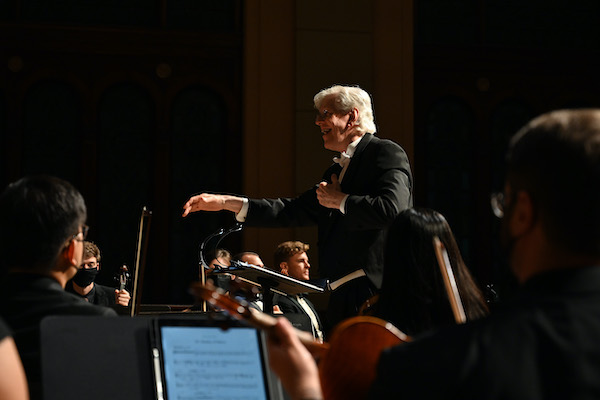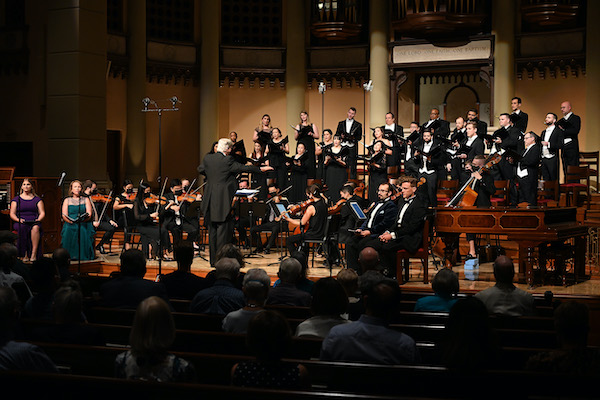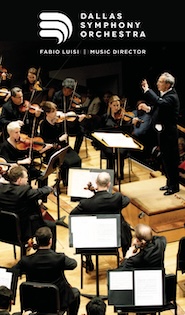Houston Chamber Choir brings glowing warmth to cantata premiere

Serenity pervades Two Streams, a new work by the young American composer Daniel Knaggs. Premiered by the Houston Chamber Choir and the Kinetic string ensemble Friday night at South Main Baptist Church, the cantata centers on the words of Saint Maria Faustina Kowalska, a Polish nun and mystic who left a diary describing visions of Jesus and the prayers they inspired in her.
In one of her visions, Jesus appeared to her with an emanation from his chest, as described in the lines that open and close Knaggs’ cantata: “Two streams in the form of rays/ Have gushed forth from the Heart of Jesus/… for the salvation of sinful humanity.”
St. Faustina emphasized mercy as the way to peace in the world, and that message dominates Knagg’s 70-minute, 14-movement cantata. In Two Streams, his music is tonal but harmonically free: It finds sweetness in gentle dissonance, but it grows pungent when the words occasionally call for intensity. Besides drawing on the full choir’s texture and impact, Knaggs sometimes marshals the men’s deep, somber tones or the women’s sweetness depending on the text.
In the Prologue and Epilogue invoking the vision of the two streams, the music’s euphony and lilt embody the cantata’s overarching air of hope. The airy, dancing motion of “Mercy to Others” captures the optimism of Faustina’s desire to go through life doing good.
When “Merciful Heart” invokes the image of a dewdrop on a flower, a sudden twist of harmony conjures the threat of “the frost of the world.” In “Mother of Mercy,” a salute to the Virgin Mary, the choir’s mellifluous lines bring raptness to the refrain, “I saw the Blessed Virgin, unspeakably beautiful.” The work climaxes in the penultimate movement with the choir’s ringing calls for the earth, sea and sun to join in a hymn to God.
The strings add their own color and atmosphere. The cantata begins ethereally, with a theme that moves from the high strings down into the rest of the ensemble; the motif returns later when the words relate to the crucifixion. The strings’ excited trills launch four movements titled “Song of Mercy,” though the music takes different turns from there each time. “Meditation,” for strings alone, leads from pensiveness through a cheerier turn to repose.
As if all that weren’t enough for one cantata, Two Streams surrounds Faustina’s words with passages based on biblical and liturgical quotations, sung in Latin, that shed further light on the topics she invokes, from mercy to the Virgin Mary. These sections are often compelling in their own right.
Mark Diamond brought resonance and urgency to the baritone solos—sometimes singing Jesus’s words and at other times, Faustina’s own thoughts. Even when his high notes betrayed a bit of strain, the message came through
Yet for all the import of the topic, Knaggs may be trying to stuff too much into one work. As the music goes back and forth among Faustina, Bible and liturgy—sometimes repeatedly in a single movement—the cantata loses dramatic momentum. And the grand Handelian fugue that caps off the next-to-last movement seems out of place. Two Streams might be more compelling if it was tightened up and focused more exclusively on the passages inspired by Faustina.

Still, the Houston Chamber Choir and Kinetic, led by Robert Simpson, brought the work conviction, clarity, warmth and impact. For all the texture and glow the group gave the lyrical sections, the group’s precise diction often lent Faustina’s words the immediacy of speech.
In “Thick Darkness,” a lament about the world’s sinfulness, shadowy sounds gave way to an outcry when the text declared that “the Lord will arise.” The group captured the lilt of “Mercy to Others” as readily as the trumpetings of the climactic “Come, O Earth.”
The soloists lent a fervor of their own. Soprano Caitlin Aloia filled the joyful first “Song of Mercy” with brightness and vibrancy. Opera star (and Rice University alumna) Sasha Cooke proved rich casting for a choral premiere, lavishing her full-throated, ardent mezzo-soprano on the Virgin Mary’s “I am Mother to you all.”
Tenor Christopher Bozeka sang with a ring and freshness that put over the conviction of the third “Song of Mercy,” a call for sinners to trust God’s forgiveness. Whether the baritone solos represented Jesus’ words or Faustina’s own thoughts wasn’t clear yet Mark Diamond brought resonance and urgency. Even when his high notes betrayed a bit of strain, the message came through.
Kinetic’s 16 players supported all this adroitly, whether the group was setting the opening’s ethereal tone, accenting the choir’s outburst in “Thick Darkness,” injecting excitement into the “Song of Joy” trills or enhancing the lilt of “Mercy to Others.” In the “Meditation,” where it played without a conductor—its specialty—the group captured the pensiveness of the richly woven counterpoint and the buoyancy of the cheerier movements.
The concert with the first movement of Grażyna Bacewicz’s Concerto for String Orchestra. Kinetic treated the music with a vigor, eagerness and red-blooded sound that would have befitted a larger group.
Daniel Knaggs’ Two Streams, performed by the Houston Chamber Choir and Kinetic string ensemble, will be available for on-demand viewing beginning September 26. houstonchamberchoir.org.
